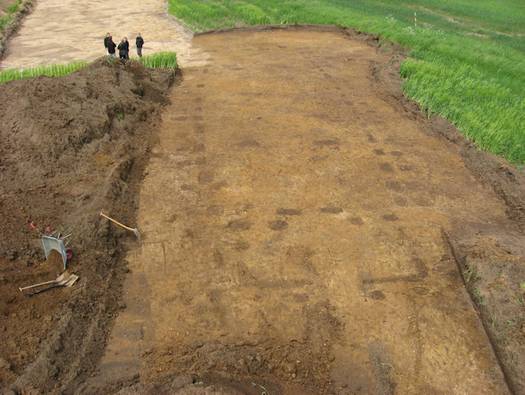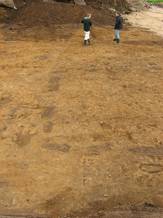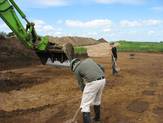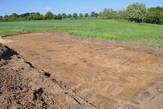Do we have the remains of Harald Bluetooth’s fortress at Jelling?
June 16, 2010
Over recent days archaeologists in Jelling have found traces of buildings from the Viking Age. Including this find, three c.23 metre long house sites of the Trelleborg type have now been revealed. They are placed completely regularly inside a large palisade, which is also being uncovered. Jelling in this way becomes a combination of the royal locations at, for example, Lejre and Tissø, and the more military type of architecture known from, amongst other sites, the ring fortresses of Trelleborg and Fyrkat.
Is it traces of a complex built by Harald Bluetooth?
As part of the Jelling Project excavations have been undertaken in the last two summers in Jelling, known for the two famous Jelling rune stones and the royal mounds. In this season the archaeologists are focusing upon the sturdy palisade, which surrounds the rune stones, the mounds and the church. With its c.360 metre long sides the palisade covers an area corresponding to around six times that of Amalienborg Palace, home to the Danish royal family today.
Three new buildings from the Viking Age
Since June 7th a large digging machine has been scraping the ploughsoil off the north-eastern part of the square area enclosed by the palisade. Some very obvious post holes from three buildings have appeared, which stand out as dark areas in the light ground. The buildings are of a type that is only known from the ring fortresses of Trelleborg, Fyrkat and Aggersborg. One of them is in line with the building that was found in 2007 along the northern palisade at a distance of around 13 metres from the palisade. The two other buildings lie along the eastern part of the palisade.
Harald Bluetooth’s fortress?
For decades and centuries archaeologists, historians and others interested in the monuments in Jelling have debated whether or not there was a royal dwelling or fortress connected to the Jelling monuments.
Is it such a fortress or royal residence which has now been found in Jelling?
“The placing of the three 23 metre long buildings suggests a structural organisation that is reminiscent of the ring fortresses of the Viking Age. The plan of the houses shows that they were of the Trelleborg type and they must therefore belong to the period around King Harald Bluetooth or the time immediately after - the last part of the 900s.” says Project Leader Anne Pedersen, Senior Researcher at the National Museum.
More excavations
The archaeologists have excavated around 10,000 m2, which is only 8 % of the total area that the palisade encloses. There is therefore plenty of opportunity for them to find further remains, such as in the excavation inside the palisade during the coming weeks.
Further information:
Further information:
Director of excavation Mads Dengsø Jessen, Aarhus University, (0045) 2513 0568, farkmdj(at)hum.au(dot)dk
Project Leader, Senior Researcher at the National Museum, Anne Pedersen, (0045) 3347 3152/ 2548 8625, ape(at)natmus(dot)dk
Associate Professor Mads Kähler Holst, Aarhus University, (0045) 2299 4915, mads.holst(at)hum.au(dot)dk
Museum Inspector Steen Wulff Andersen, Vejle Museum, (0045) 2444 4458, stwan(at)vejle(dot)dk
Press photos: PR and marketing coordinator, Jesper T. Møller, (0045) 3347 3006, jtm(at)natmus(dot)dk





